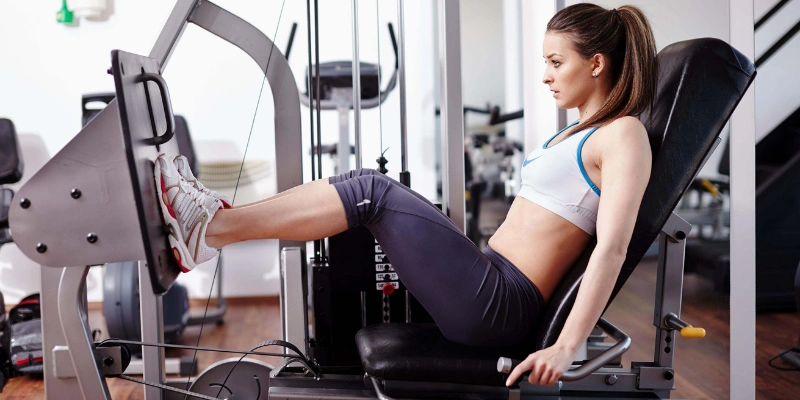Why it’s important to know gym equipment
Gym Equipment Names: Are you struggling to understand the layout of your gym? You’re not alone. For many beginners, stepping into a gym for the first time can feel like walking into a maze of mysterious machines, pulleys, and weights. With unfamiliar Gym Equipment Names on every corner, it’s easy to feel overwhelmed or use the wrong equipment. That’s why it’s important to understand the name and purpose of each piece of Gym Equipment, whether you’re new to fitness or a seasoned enthusiast looking to improve your routine.
This guide explains the names of common gym machines, what they do, and how to use them safely and effectively. From treadmills to Smith machines, we’ll cover everything you need to know in this Gym Equipment Names guide. Not only will it boost your confidence, but it will also help you train smarter, avoid injuries, and get the most out of every workout session.
If you’re looking for beginner gym tips or just want to better understand your local gym’s setup, this glossary-style article will become your go-to reference. Get ready to turn gym confusion into confidence – one tool at a time!
Gym Equipment Categories Explained (With Quick Reference Table)
Are you feeling overwhelmed by all the Gym Equipment Names in your gym? You’re not alone. From machines with pulleys and levers to simple-looking equipment with complex purposes, understanding the types of Gym Equipment Names can be a game-changer for your fitness journey.
This guide breaks it down, concisely, and with a handy gym machine chart—so you know what each piece of Gym Equipment does, which muscles it targets, and who it’s best for. Whether you’re building strength, improving mobility, or chasing cardio benefits, this list of exercise equipment names will help you.
1. Cardio Machines
These machines are designed to increase your heart rate, burn calories, and build stamina. Ideal for warm-ups or full workouts, they focus more on stamina than strength.
- Popular cardio equipment:
- Treadmills – indoor walking, jogging, or running
- Ellipticals – effortless, joint-friendly cardio
- Rowing machines – a hybrid of cardio and resistance
- Upright or recumbent bikes – low-impact pedaling power
Why use them?
Great for fat-burning, heart health, and endurance training.
2. Strength training machines
These stationary machines guide your movement and help you isolate muscle groups safely. They’re perfect for beginners who want control and support.
- Examples include:
- Leg press – lower body strength
- Shoulder press machines – target the delts and triceps.
- Chest fly machines – shape the pecs
- Cable machines – highly versatile with constant tension
Why use them?
Great for safe, progressive overload for beginners.
3. Free Weights
Free weights provide natural freedom of movement, which activates stabilizing muscles and mimics real-life functional movements. They are a favorite for building raw strength.
- Essential Free Weights:
- Dumbbells – perfect for isolation and compound moves
- Barbells – best for heavy lifters
- Kettlebells – great for dynamic, explosive workouts
- Weight Plates – used on barbells or plate-loaded machines
Why use them?
Builds more function, better range of motion, and overall strength.
4. Functional Training Equipment
This category is all about movement quality, agility, and body coordination. This equipment helps you train for real-world physical functions, sports, and overall body awareness.
- General Equipment:
- Medicine Ball – for throws and slams
- Battle Ropes – boost cardio and grip strength.
- TRX Suspension System – bodyweight-based instability
- Sandbags – asymmetrical weights for core engagement
Why Use Them?
Improves core, balance, and whole-body performance.
5. Mobility and Recovery Equipment
These tools support recovery and improve joint mobility and flexibility. Recovery isn’t just for rest days – it’s a vital part of progressing.
- Accessories:
- Foam Rollers – self-myofascial release
- Massage Guns – deep muscle stimulation
- Resistance Bands (lightweight) – ideal for stretching
- Yoga Blocks and Mats – support alignment and relaxation
Why Use Them?
Reduce pain, improve mobility, and prevent injury.
Quick Reference: Gym Machines Chart
| Name | Purpose | Muscles Worked | Best For |
| Treadmill | Cardiovascular conditioning | Legs, glutes, core | Runners, fat loss goals |
| Elliptical Trainer | Low-impact cardio | Full-body | Joint-sensitive users |
| Rowing Machine | Cardio + resistance combo | Back, legs, arms, core | Full-body efficiency |
| Leg Press Machine | Strength training | Quads, hamstrings, glutes | Lower-body gains |
| Chest Fly Machine | Upper body isolation | Pectorals | Chest sculpting |
| Dumbbells | Strength & flexibility | Varies by movement | Versatile strength routines |
| Kettlebells | Dynamic strength | Core, shoulders, legs | Functional fitness |
| TRX Suspension Trainer | Bodyweight-based strength | Core, stabilizers | Balance and endurance workouts |
| Foam Roller | Muscle recovery | Fascia, connective tissue | Pre/post-workout recovery |
| Massage Gun | Deep tissue relief | Targeted muscle zones | Recovery, soreness relief |
You don’t have to feel lost when you walk into the Gym Equipment Names. With this clear description of types of gym equipment and a handy exercise Gym Equipment Names list, you’ll not only feel more confident but also train smarter. Use the gym machines chart as your cheat sheet to match your goals to the right gear.
Ready to perfect your next workout? Bookmark this guide and get moving!
Cardio Machines: Burn Fat and Boost Heart Health
If your goal is to lose fat, increase stamina, and keep your heart in top shape, cardio machines are your best allies. This cardio Gym Equipment name is a staple in every fitness center, offering both beginners and pros an efficient way to burn calories and increase stamina.
From treadmills to stair-climbing machines, each machine uniquely targets your cardiovascular system. This guide covers the top gym equipment names in the cardio category, along with practical usage tips, quick calorie burn notes, and beginner-friendly insights.
Popular Cardio Gym Equipment Names
1. Treadmill
- Calorie Burn: 250-400+ per 30 minutes (moderate to intense pace)
- Usage Tip: Incorporate inclined walking or interval sprints for faster fat loss.
- Best for: Running, walking, incline training
- Advantages: Natural movement, adjustable speed/incline
- Disadvantages: High impact on joints
2. Elliptical trainer
- Calorie burn: 200–350 per 30 minutes
- Usage tip: Use the handlebars to activate the upper body and boost calorie burn.
- Best for: Low-impact full-body cardio
- Advantages: Joint-friendly, works both the upper and lower body
- Disadvantages: Less natural feel than walking or running
3. Stationary bike
- Calorie burn: 180–300 per 30 minutes
- Usage tip: Adjust the resistance level for intervals or steady fat-burning rides.
- Best for: Knee-friendly lower body cardio
- Pros: Great for beginners and people with joint pain
- Cons: Limited upper body involvement
4. Rowing Machine
- Calorie burn: 250-350 per 30 minutes
- Tips: Focus on form—push with legs, lean back, pull with arms.
- Best for: Full-body cardio and muscle toning
- Pros: Involves more than 80% of muscle mass
- Cons: Requires proper technique to avoid injury
5. Stair Climber
- Calorie burn: 220-400 per 30 minutes
- Tips: Keep your body upright, and avoid leaning too much on the handrails.
- Best for: Glute and leg toning + intense cardio
- Pros: High calorie burn, leg strength
- Cons: Steep learning curve for beginners
Embedded FAQ: Answers to your cardio questions
Q: Which cardio machine burns the most fat?
Answer: Treadmills and stair climbers often top the list for burning the most calories due to their ability to simulate intense, weight-bearing activity. However, the rowing machine is also incredibly effective because it involves both the upper and lower body, maximizing effort and fat burn. Intensity and consistency are important, no matter the name of the Gym Equipment you use.
Q: Which cardio is best for beginners?
Answer: Elliptical trainers and stationary bikes are best for beginners due to their low-impact nature and ease of use. These cardio Gym Equipment Names help you build stamina safely while minimizing joint stress. As you progress, you can explore other machines, such as the treadmill or rowing machine.
When it comes to gym equipment for weight loss, cardio machines play a key role. By understanding the purpose and best use of each Gym Equipment, you can optimize your workouts for maximum fat loss and heart health. Whether it’s the ongoing debate of treadmill vs. elliptical or deciding which machine best suits your fitness level, the right cardio plan starts with the right machine—and the right mindset.
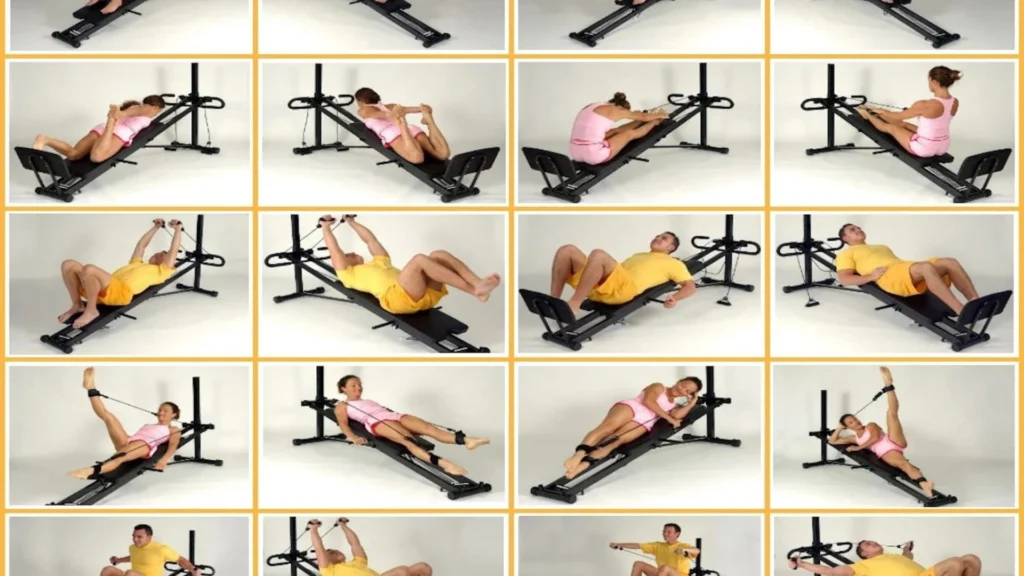
Strength Building Machines: Build Muscle the Safe Way
When stepping into the gym, one of the most effective and beginner-friendly ways to build strength is through strength-building machines. Gym Equipment Names: These powerful pieces of muscle-building gym equipment are designed to help you focus on form, properly isolate muscles, and reduce the risk of injury.
Unlike free weights that demand balance and stability, machines provide guided paths of motion, making them the perfect gym machines for beginners. Whether you want to tone your muscles, increase strength, or prepare your body for advanced lifts, these machines are your safest starting point.
Why Use Strength-Building Machines?
- Strength-building machines allow you to:
- Target specific muscle groups with controlled motion
- Minimize the risk of improper form.
- Train safely without a spotter.
- Increase resistance as you build strength.
- By keeping your posture and range of motion consistent, this gym equipment helps you get stronger without the guesswork.
- Must-Know Names of Gym Equipment for Strength Training
Here are four of the most popular strength training machines found in modern gyms, along with usage tips and beginner’s notes to guide you.
1. Chest Press Machine
- Purpose: Strengthens the chest, shoulders, and triceps
- Why it works: Provides a steady pushing movement without balancing the barbell.
- Beginner’s Tip: Keep your back flat on the pad and elbows slightly below shoulder height for maximum activation.
- Bonus: As you get better, gradually adjust the resistance – great for upper body development.
2. Leg Press Machine
- Purpose: Builds strength in your quads, hamstrings, and glutes
- Why it works: Allows for a heavy leg workout while seated, reducing stress on the spine.
- Beginner tip: Don’t let your knees lock completely at the top of the movement – keep tension on the legs the whole time.
- Ideal for: Anyone who struggles with barbell squats or has knee problems.
3. Lat Pulldown Machine
- Purpose: Targets the back, particularly the latissimus dorsi (lats), as well as the biceps and shoulders
- Why it works: Trains vertical pulling strength and improves posture and upper body balance.
- Beginner tip: Smoothly pull the bar up to your chest while keeping your back straight and core tight. Avoid using momentum.
- Great choice: For bodyweight pull-ups, especially for beginners.
4. Cable machine
- Purpose: Offers a variety of exercises for full-body strength training
- Why it works: The pulley system allows for dynamic, fluid motion and resistance throughout the movement.
- Beginner tip: Start with basic cable bicep curls, tricep pushdowns, and chest flyes to build coordination and control.
- Versatility: From arms to abs and legs – this machine does it all.
- Visual learning: Build confidence with pictures
- To enhance your understanding, consider the image-based callouts next to each gym machine. These visuals may include:
- Labeled muscle groups worked
- Step-by-step movement guides
- Common mistakes to avoid (e.g., overextending, poor posture)
Having these images next to each gym equipment name helps beginners understand the machines and build confidence in using them correctly.
Final Thoughts
For anyone starting a strength journey, muscle-building gym equipment like a chest press machine or cable station provides a safe and structured way to train Gym Equipment Names. These strength training machines eliminate the fear of poor form, support consistent progression, and are widely considered the safest path to long-term strength development.
Whether you’re brand new or just getting back to the gym after some time away, these gym machines for beginners can help you build strength effectively, one safe rep at a time.
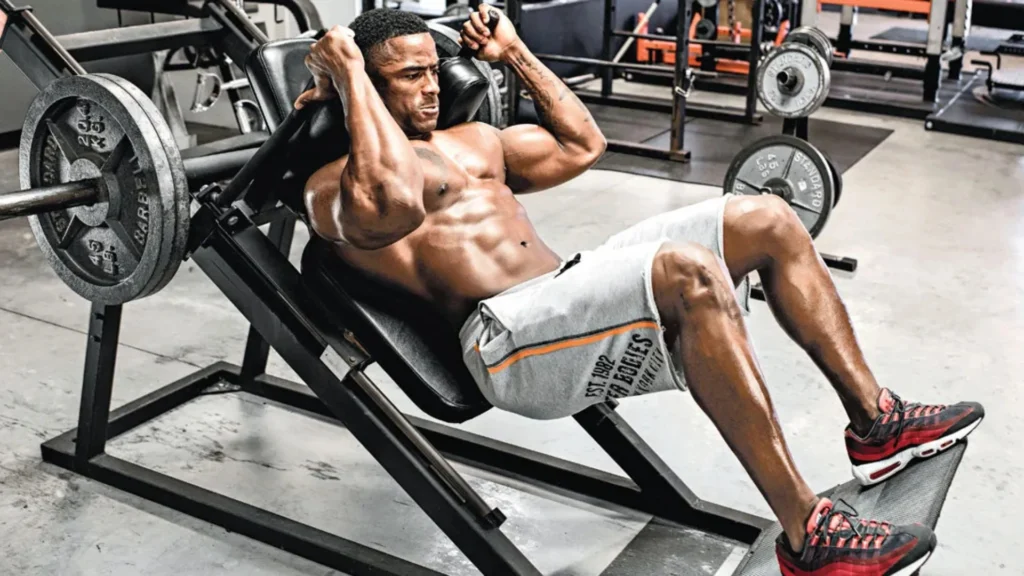
Free Weights: Dumbbells, Barbells, and Kettlebells
When it comes to building strength and functional fitness in the real world, there’s nothing better than free weights. These timeless tools—dumbbells, barbells, and kettlebells—require your body to activate multiple muscles at once, improving not only strength but also balance, coordination, and control.
Unlike machines that move you along a fixed path, free weights allow for natural movement. That means you don’t just lift weights—you also stabilize, balance, and correct your posture in real time. This added complexity makes free weights a must-have for anyone who wants long-term strength and whole-body results.
What makes free weights so effective?
Using free weights isn’t just about lifting heavier weights—it’s about training smarter. Each movement with the namesake of these gym tools mimics everyday actions, which is why they’re considered the gold standard in functional training.
- The benefits of free weights include:
- Greater range of motion
- Increased core activation
- Improved coordination and joint stability
- Adaptable to any fitness level
They’re also perfect for progressing at your own pace, whether you’re doing a beginner dumbbell workout or a heavy barbell squat.
Essential Free Weight Equipment
Let’s look at the major free weight equipment found in most gyms:
1. Dumbbells
- Uses: Great for both isolation (e.g., bicep curls) and compound moves (e.g., dumbbell chest press)
- Workout Focus: Improves symmetry and unilateral strength
- Popular dumbbell workout moves: Goblet squats, Arnold press, renegade row.
- Why it works: Each arm works independently, forcing balance and equal effort.
2. Barbells
- Uses: Ideal for building maximum strength with heavy compound lifts
- Common barbell equipment names: Olympic bar, hex bar (trap bar), EZ curl bar, squat bar
- Workout Focus: Squats, deadlifts, bench press, overhead press
- Why it works: Allows the body to lift heavier loads efficiently and builds whole-body power.
3. Kettlebells
- Uses: Combines cardio and strength in a single workout
- Effective kettlebell uses: Kettlebell Swing, Turkish get-up, clean, snatch
- Workout Focus: Explosive power, coordination, and endurance
- Why it works: Offset weights challenge your grip, core, and balance like no other equipment.
Adjustable vs Fixed Free Weights
Understanding the type of weight setup is just as important as the weight itself. Here’s a quick breakdown:
| Type | Description | Best For |
| Adjustable Weights | Change the weight plates or dial to customize the load | Small home gyms, space-saving setups |
| Fixed Weights | Pre-set dumbbells, barbells, or kettlebells | Commercial gyms, quick transitions, and supersets |
Note: Adjustable weights are more economical, while fixed weights offer convenience and speed in workouts.
Pro Tip Box: How to Choose the Right Weight
Don’t know where to start with your dumbbell workout or barbell set? Here’s how to find your ideal load:
- Form First: Choose a weight you can control for 8-12 reps with perfect form
- Challenge, Not Strain: You should feel challenged by the last 2 reps, but not at risk
- Progressive Overload: Gradually increase the weight or reps as your strength increases
- Listen to your body: Too light? You’re wasting time. Too heavy? You’re risking injury. Find the middle ground and go from there.
- Remember: Proper form > heavier weights, every time.
Final Thoughts
Free weights—dumbbells, barbells, and kettlebells—are the heart of any serious strength program. Their ability to work multiple muscles, improve balance, and mirror real-life movements makes them irreplaceable in your gym routine.
By learning how to use each gym equipment name correctly, understanding barbell Gym Equipment names, mastering kettlebell use, and tailoring your dumbbell workouts to your goals, you’re not just lifting weights – you’re building a strong, capable, and injury-resistant body.
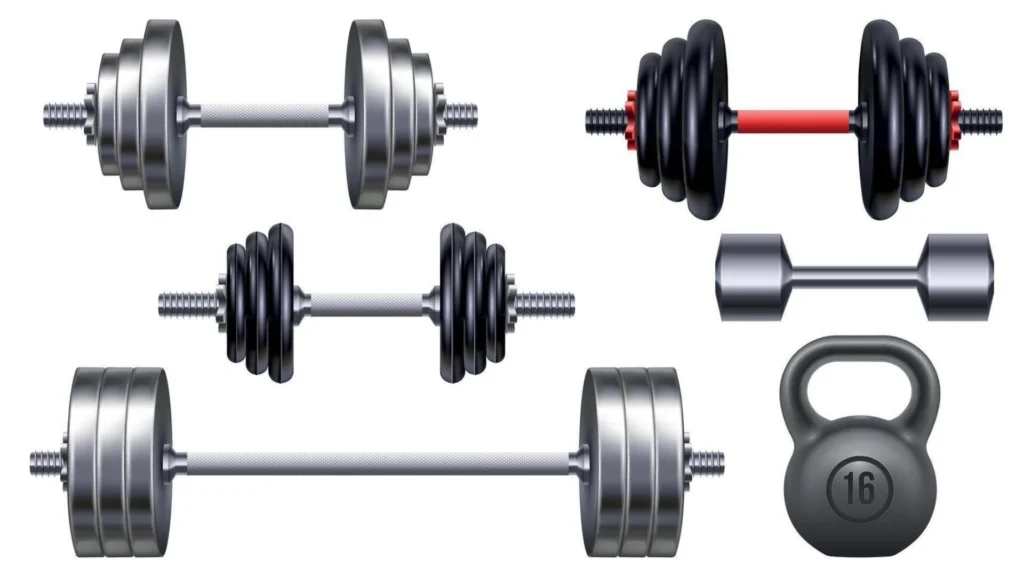
Functional Training Equipment: Dynamic Fitness Equipment
In today’s fast-paced fitness world, people want Gym Equipment Names that mimic real-life movements, build core strength, and enhance overall performance. That’s where functional training equipment comes in. These versatile pieces of Gym Equipment improve coordination, flexibility, and strength, and keep your workouts exciting at the same time.
Whether you’re setting up a compact home gym or want to spice up your gym routine with high-intensity exercises, functional equipment like TRX straps, resistance bands, battle ropes, and slam balls offers endless possibilities.
Why Choose Functional Training Equipment?
Functional training focuses on movements that improve everyday strength and stability. This equipment challenges your balance, activates your core, and promotes dynamic full-body control – unlike machines that limit your range of motion.
Benefits include:
- Improved mobility and injury prevention
- Full body activation in less time
- Portable and perfect for home gyms
- Ideal for HIIT, circuit training, and rehab
- Popular Functional Gym Equipment Names
Let’s break down four of the most effective functional training equipment that belong on any home gym equipment names list:
1. TRX Suspension Straps
- Uses: Bodyweight exercises targeting the core, upper, and lower body
- How it works: Anchor over a door or bar; Adjust angle for intensity
- Best for: Core stability, flexibility, and scalable strength
2. Resistance Bands
- Uses: Great for toning, warm-ups, and rehabilitation
- Top resistance band exercises: Glute bridges, banded rows, squats, shoulder raises
- Why it’s effective: Lightweight but powerful, these bands provide constant tension and are adaptable to all fitness levels.
3. Battle Rope
- Uses: High-intensity cardio and strength
- Workout benefits: Increases endurance, burns calories faster, and strengthens arms, shoulders, and core
- Perfect for: Explosive power, stress relief, and upper body conditioning
4. Slam Ball
- Uses: Explosive power and coordination
- Specific moves: Ball slams, rotational throws, overhead tosses
- Great for: Building explosive power while engaging your whole body
Why functional tools work great in a home gym
Gym Equipment Names: These compact, portable tools take up minimal space and provide maximum results, making them the ideal home gym equipment. From suspension training in your living room to banded squats in your backyard, you can train anywhere – no bulky machines required.
FAQ: What’s the difference between functional and traditional equipment?
Q: What’s the difference between functional and traditional Gym Equipment Names?
Answer: Traditional gym equipment (like chest press or leg curl machines) isolates specific muscles using guided motion – ideal for beginners or targeted muscle development.
However, functional training Gym Equipment challenges your whole body to move in more natural ways. They emphasize core engagement, multi-joint coordination, and balance, helping you perform better in daily life, sports, and physical tasks.
- In a nutshell:
- Traditional equipment = muscle isolation
- Functional equipment = movement efficiency + total-body strength
Functional training equipment like TRX straps, resistance bands, battle ropes, and slam balls is revolutionizing the way we train. They’re included on every list of effective home gym equipment names because they offer variety, challenge, and real-world results.
So, whether you’re looking to build total body control or looking for the best resistance band exercises, incorporating these gym equipment names into your routine can help you move, perform, and live better every day.
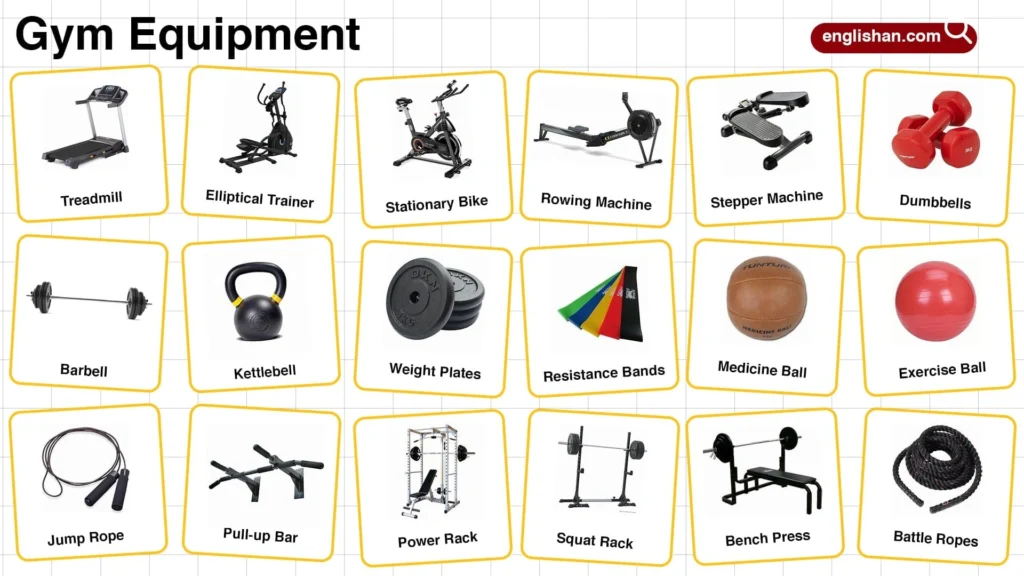
Equipment for mobility, recovery, and flexibility
In the world of fitness, it’s easy to focus on lifting heavier weights or running faster. But what’s often overlooked is the gym equipment name category that supports long-term progress: mobility, recovery, and flexibility equipment. These underrated essentials – like foam rollers, yoga blocks, and massage balls – are crucial to keeping your body pain-free and preventing injuries before they start.
Whether you’re an athlete, gym enthusiast, or beginner, incorporating these tools into your routine can significantly improve your range of motion, reduce muscle tightness, and speed recovery after a tough workout.
Why recovery gym equipment matters
Recovery isn’t just about rest – it’s an active part of any successful training program. Gym Equipment Names Recovery helps relax tight muscles, improve blood circulation, and prepare your body for the next session. Skipping mobility work can lead to chronic stiffness, poor posture, and an increased risk of injury.
Benefits include:
- Faster muscle recovery after a workout
- Improved joint mobility and quality of movement
- Reduced risk of injury and muscle imbalances
- Increased flexibility and improved exercise performance
- Names of essential gym equipment for mobility and recovery
1. Foam Rollers
- Uses: Myofascial release – loosening tight muscles and fascia
- Top foam roller uses: Target sore quads, hamstrings, back, knees, and calves.
- Best for: Pre-workout warm-up and post-workout cooldown
- Why it’s effective: Improves blood flow, reduces pain, and aids in tissue recovery.
2. Yoga Blocks
- Uses: Supports and deepens stretching poses
- Benefits: Helps beginners maintain form and alignment in flexibility training
- Great for: Hamstring stretches, hip openers, chest expansions
- Added value: Lightweight and perfect for home or studio workouts
3. Massager Balls
- Uses: Precise pressure release of muscle groups in small sizes
- How it helps: Reaches tight spots in the neck, shoulders, legs, and glutes.
- Ideal for: Targeted recovery and mobility enhancement in hard-to-reach areas
The role of mobility in functional fitness
Incorporating mobility Gym Equipment Names into your training routine isn’t optional—it’s essential gym Equipment Names. These tools help create balance in the body, especially if you’re lifting heavy weights, sitting for long periods, or doing high-impact cardio.
Regular use of foam rollers, yoga blocks, and other recovery Gym Equipment ensures your body stays agile, mobile, and strong.
Final Thoughts
Gym Equipment Names Although foam rollers, yoga blocks, and massage balls don’t look as intense as barbells or treadmills, they’re some of the most valuable gym equipment names for long-term health and fitness.
They may not be as flashy, but these mobility Gym Equipment Names pieces are the key to unlocking performance, preventing injury, and staying consistent in your workouts. If you’re not already using recovery Gym Equipment Names, now’s the time to roll, stretch, and breathe for better movement.

Gym Equipment FAQ (Targeted Featured Snippet)
Walking into a gym full of unfamiliar machines can feel like stepping into a science lab. To help you get the most out of your workout, we’ve answered some of the most frequently asked questions about Gym Equipment Names. Each answer is designed to be quick to read, ideal for Google’s featured snippet format, and your next gym session. What is the most used gym equipment?
The most used Gym Equipment name is the treadmill. It’s the best choice for people who want to burn calories, warm up before strength training, or improve cardiovascular endurance. Gym Equipment Names Other popular machines include: Elliptical – provides a low-impact cardio workout Cable machine – versatile for many strength exercises Dumbbells – found in every gym for full-body free weight training Leg press machine – a great choice for lower body strength These are loved not only for being easy to use, but also for being the foundation for most training plans.
What are the Gym Equipment Names of leg machines? There are many gym equipment names designed specifically for training the legs. Whether you’re targeting quads, hamstrings, glutes, or calves, here’s a quick description:
- Leg press – pushes weights with your legs; Great for the quads and glutes.s
- Leg curl machine – isolates the hamstrings.
- Leg extension machine – targets the front thigh muscles (quads)
- Hack squat machine – provides support during squatting movements.
- Hip abduction/adduction machines – strengthen the inner and outer thighs
- Standing calf raise – focuses on the calf muscles.
If you’re new, ask a trainer to explain how to use the Gym Equipment Names for leg day to prevent injury and maximize results.
Which Gym Equipment Names are best for beginners?
For people who are just starting their fitness journey, some gym equipment names are more accessible and beginner-friendly. This equipment is designed with simplicity and safety in mind:
- Stationary bike – low-impact cardio, easy on the joints
- Treadmill (with safety clips) – lets you get started at your own pace.
- Seated chest press – builds upper body strength with guided motion.n
- Lat pulldown machine – ideal for back strength and posture improvement
- Resistance bands – lightweight, safe, and great for learning
- Cable machine – adjustable and suitable for full-body workouts
Most beginner-friendly machines provide labeled instructions. But when in doubt, ask your Gym Equipment Names staff or watch fitness equipment explained videos for a guided demo.
Final words
Understanding the purpose and function behind each gym equipment name is the first step to using it correctly and safely gym Equipment Names. These answers are intended to simplify how to use gym machines, giving you confidence every time you head to the gym.
Don’t skip the small Gym Equipment Names like resistance bands and cable machines may seem simple, but they play a big role in building strength and mobility.
Want even more clarity? I can create a visual chart of Gym Equipment Names by muscle group, helping your readers choose the right equipment for every workout!
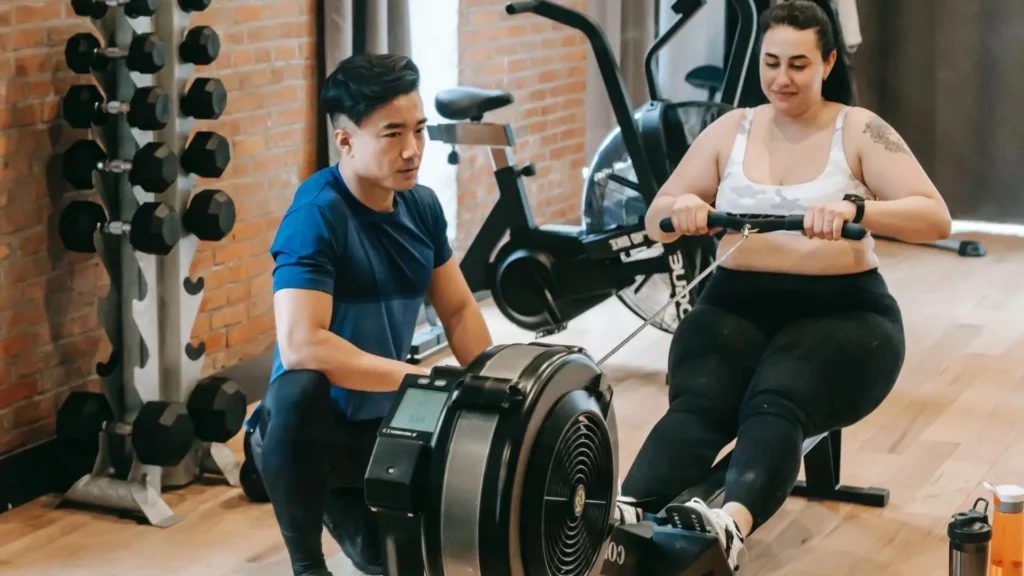
Conclusion: From Confusion to Confidence
Stepping into a gym full of machines, cables, and weights can feel overwhelming, but it doesn’t always have to be. With a better understanding of each gym piece of Gym Equipment Names and what it’s designed for, you’re already on your way to training better and more effectively.
Gym Equipment Names Whether you’ve just decoded the purpose of the lat pulldown machine, learned how to use free weights correctly, or discovered the benefits of mobility tools, knowledge is your newfound power. The next step? Action.
Try it: Pick a new piece of equipment you’ve never used before and give it a try this week. Gym Equipment Names Start lightly, pay attention to form, and be proud of every rep.
Call to Action:
Which machine did you finally master? Was it the elusive cable machine or maybe the foam roller you’ve never touched before?
Share your experience in the comments below! Your journey might inspire someone else to conquer their fear of unfamiliar equipment.
From cardio to strength, recovery to functional fitness – every gym equipment name you know and recognize brings you one step closer to confidence and results.
Read about Sports with Duniya Sports
Gym Equipment Names: youtu.be/5DN2lznQkyw?

